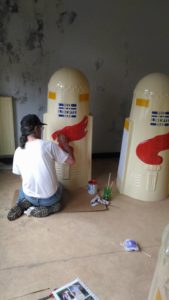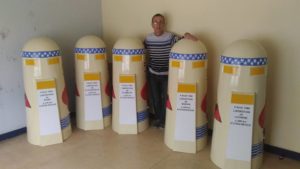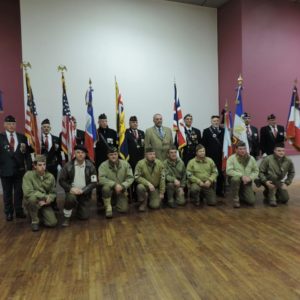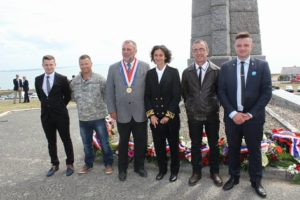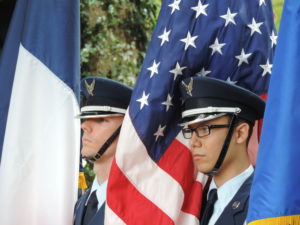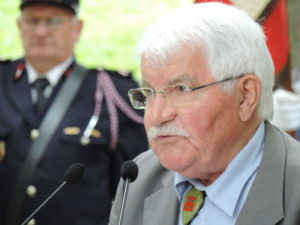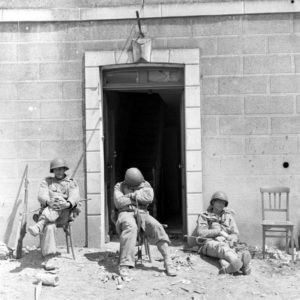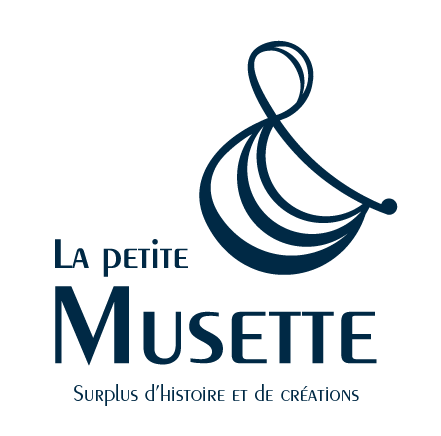by Bertrand Froger | 24 Oct 2017 | Anecdotes, Historical events, Places
A new port and already destroyed.
From June 19, 1944 and for several days, the beach of Omaha invested by the Allies a few days earlier will be swept by a heavy storm mixed with strong tidal coefficients. The record is heavy: the artificial port “Mulberry A” is now out of use while the progress of the front continues. It is then necessary to unload and then destroy damaged ships on the beach in order to free access to the next landings of men, equipment and vehicles.
-
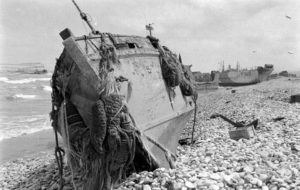
-
Omaha, après la tempête du 19 au 21 juin 1944, des épaves échouées sur les galets dont le MK4 britannique LCT-969
Voir le reportage sur les épaves à Omaha après la tempête:
https://www.flickr.com/search/?sort=date-taken-desc&safe_search=1&tags=epaveomaha&user_id=58897785%40N00&view_all=1
Pour aller plus loin:
http://omahabeach.vierville.free.fr/WebMulberry/85132-EpavesTempete.html
-
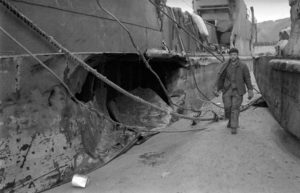
-
A Omaha, après la tempête du 19 au 21 juin 1944, un marin de l’US Navy marche entre des épaves échouées, à gauche un LCT (6)
le même marin et certainement le même LCT en LC001673 et LC001678:
https://www.flickr.com/photos/mlq/33492374435/in/photolist-T2Bb4D
Voir le reportage sur les épaves à Omaha après la tempête:
https://www.flickr.com/search/?sort=date-taken-desc&safe_search=1&tags=epaveomaha&user_id=58897785%40N00&view_all=1
Pour aller plus loin:
http://omahabeach.vierville.free.fr/WebMulberry/85132-EpavesTempete.html
-
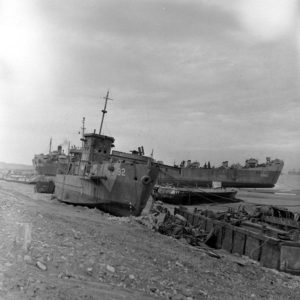
-
Vierville sur Mer, à la limite Dog White et Dog Red, sur un talus de galets, les épaves du LCI(L)-92 échoué depuis le 6 juin et celle du LST-543 échoué depuis la tempête du 19 au 21 juin.
LCI-92 pour aller plus loin:
http://omahabeach.vierville.free.fr/2622-LCI92.html
LST-543 pour aller plus loin:
reportage sur le LST-543 avant son échouage:
https://www.flickr.com/photos/mlq/8096446665/in/photostream
LST-543 échoué:
https://www.flickr.com/search/?sort=date-taken-desc&safe_search=1&tags=lst543&user_id=58897785%40N00&view_all=1
Voir le reportage sur les épaves à Omaha après la tempête:
https://www.flickr.com/search/?sort=date-taken-desc&safe_search=1&tags=epaveomaha&user_id=58897785%40N00&view_all=1
The importance of other ports.
Although troops and equipment will still be brought to Omaha in small quantities, it is the artificial ports installed on the other beaches of the Allied Landing will engulf this profusion of supplies. Thus, Mullberry ports such as Gold-Arromanches or Gooseberry of Utah-Sainte Marie du Mont, will play a key role in the supply of the front and the advance of the latter. For the example of Utah, it is not less than 836 000 men who will tread the sand of this small beach during the year 1944 because although the port of Cherbourg is released at the end of June, this one is unusable.
-
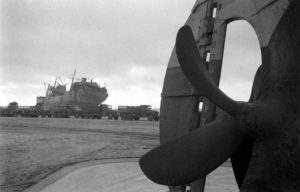
-
A Omaha, après la tempête du 19 au 21 juin 1944, un cargo échoué, en cours de déchargement à l’aide d’un convoi de GMC.
au premier plan l’hélice d’un second cargo également échoué
voir le reportage sur deux cargos échoués:
https://www.flickr.com/search/?sort=date-taken-desc&safe_search=1&tags=gmcomaha&user_id=58897785%40N00&view_all=1
Voir le reportage sur les épaves à Omaha après la tempête:
https://www.flickr.com/search/?sort=date-taken-desc&safe_search=1&tags=epaveomaha&user_id=58897785%40N00&view_all=1
Pour aller plus loin:
http://omahabeach.vierville.free.fr/WebMulberry/85132-EpavesTempete.html
-
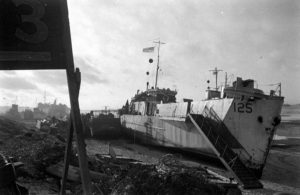
-
A Omaha, après la tempête du 19 au 21 juin 1944, plusieurs épaves dont le LCI(L)-125
http://www.navsource.org/archives/10/15/150125.htm
Voir le reportage sur les épaves à Omaha après la tempête:
https://www.flickr.com/search/?sort=date-taken-desc&safe_search=1&tags=epaveomaha&user_id=58897785%40N00&view_all=1
Pour aller plus loin:
http://omahabeach.vierville.free.fr/WebMulberry/85132-EpavesTempete.html
-
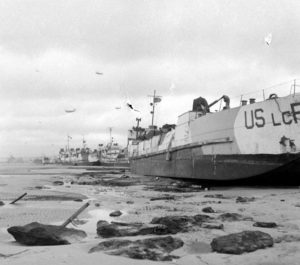
-
A Omaha, après la tempête du 19 au 21 juin 1944, plusieurs épaves échouées dont un Landing Craft (Flak) LCF échoué.
Voir le reportage sur les épaves à Omaha après la tempête:
https://www.flickr.com/search/?sort=date-taken-desc&safe_search=1&tags=epaveomaha&user_id=58897785%40N00&view_all=1
Pour aller plus loin:
http://omahabeach.vierville.free.fr/WebMulberry/85132-EpavesTempete.html
(Credits : NARA)
by Bertrand Froger | 5 Sep 2017 | Celebrations, Places, To be visited, WW2 News
Liberation road markers… in Britain!
The initiative of Jacky Cadoux is not the least. Inspired by the Road markers of Liberty established on our territory from Normandy to the Belgian Ardennes, this enthusiast realizes the project to erect on 5 Breton municipalities of the Bornes of the Liberation retracing the course of the 4th American Armored Division on this sector. The communes selected and participating in the project are Plumelec, St Jean Brevelay, Bignan, Locmine and Baud. These monuments will be placed this week and inaugurated on October 28, 2017 starting with that of Plumelec (56420) at 9:30 am!
And so many others projects!
Jacky Cadoux is also president and a very active member of the association Souvenir Militaire Center Morbihan which aims to perpetuate the Remembrance and the Memory of the military facts carried out in Brittany during the XXth century. The club is organizing its 3rd Military Antiquities Fair, which will take place on November 12nd in Locminé (56) (Halle des Sports, Rue de la Bouillerie), which will enable the association to finance other commemorative and memorial projects.
More informations on the page of the association:
Souvenir Militaire Centre Morbihan
(Credits photos : Jacky Cadoux, Souvenir Militaire Centre Morbihan)
by Bertrand Froger | 2 Jul 2017 | Celebrations, Historical events, Places, WW2 News
A monument for Benjamin F. Kitchens and Bert Espy Jr
On June 24th, following the invitation of our friend Christian Levaufre, we gathered to inaugurate the memorial in memory of the two American airmen Benjamin F. Kitchens and Bert Espy Jr in Périers (50). Day after day 73 years, when the two pilots join their formation after firing German vehicles, Espy’s P-47 propeller will cut the back of the Kitchens aircraft. This terrible accident ended with the Thunderbolt crash and the death of the two USAAF officers. After a long research work carried out over decades by the Levaufre family and the association Normandy 44, Espy’s plane is found (that of Kitchens was thrown) and its engine cleaned. It is thus affixed at the top of this memorial unveiled this June 24th, 2017 in the presence of the French-American authorities but also of the pilot’s niece. A beautiful tribute, the loop is closed, because maintaining the flame of memory is 365 days a year.
All died for our Freedom
“Not all died as Heroes, but all died for our Freedom,” is the sentence quoted on the panel explaining the misadventure of these two airplanes. It is well to remember that no war is proper, and that no war is conducted without error. Among the millions of people who died in the Second World War, many of them were victims of fratricidal shooting because of problems of location, accidents at sea, in the air and on the land. Thus, although all these young men had sacrificed their lives for the liberation of our continent, many of them would surely have been able to return home if these errors had not occurred. We do not forget them either.
by Bertrand Froger | 22 Jun 2017 | Anecdotes, Places, To be visited
The streets of Carentan, witnesses of another time.
These three elements of the 327th Glider Regiment allow a moment of rest during the occupation of the city of Carentan following the liberation of the town. Landed on Utah Beach mainly on June 7th, 1944, this unit was originally intended to invade the land by gliders. It is an integral part of the 101st Airborne Division, which does not only include paratroopers. Men wear similar equipment, such as the famous US M1 rifle in its foldable butt version.
The Liberty Road, place where a lot of photos were taken.
But these elements of the 327th GIR were resting against the gable of a house are not alone and if you turn in the street, other soldiers also poke a nap. The third photo identifies this zoom. The Désiré Ingouf Café no longer exists and a new building, more or less similar has pushed in its place. However, the windows leave no doubt about the location of this snapshot. In addition, the color circles will allow you to locate yourself.
by Bertrand Froger | 9 Jun 2017 | Celebrations, Places, To be visited, WW2 News
An inauguration in grand manner
On Monday, June 5th, 2017, more than 300 people gathered to inaugurate the new stele in honor of Major John E. Tucker on the bridge between Carentan and Saint-Hilaire-Petitville. In order to unveil this block of granite where are reproductions of the 1944’s steles and emblem of the American corps of engineers, many civil and military authorities have made the displacement. Among them: Mister Lhonneur, Mayor and President of the community of communes of Carentan-les-Marais; Mr. Fauny, Mayor of Saint-Hilaire-Petitville; George K. Mullins, veteran of the 101st Airborne Division, General Glenn Goddard, elected officials, orchestra, US Army with color guard … A ceremony punctuated with moving speeches at the height of the event.
The culmination of a memorial project
It was in 2016 that Bertrand Froger launched a call from his Facebook page (Normandy 1944, Follow the Guide!), Affected by the disappearance of the stelae in homage to Major Tucker killed in action in June 1944. They had been implanted following his death by his men of the 300th Engineer Combat Battalion and citizens of the area. The project is taking shape, supported by the two municipalities, and then a participatory fundraising campaign is launched. Hundreds of people relay this action, dozens contribute, individuals and associations. The objective is achieved and the funds raised. On June 5th, 2017, Major Tucker’s honor is safe and his memory preserved and honored.
by Bertrand Froger | 29 May 2017 | Celebrations, Places, To be visited
Memorial Day, history of a celebration.
At the end of the Civil War, it was customary for the graves of the fallen American soldiers to be covered with flowers on a particular annual date. On May 5th, 1868, this day became a holiday of the calendar. On May 30th, 1868, it was named “Decoration Day” and celebrated at the Arlington National Cemetery. In 1882, it was renamed “Memorial Day” to celebrate all the dead in combat of all the wars involving American soldiers and not only those killed during the American Civil War. In 1967, Memorial Day extended to the federal level and a year later, the Congress adopted the Uniform Monday Holiday Act, moving that day to the last Monday in May, to propose a three-day weekend. This Act comes into force on January 1st, 1971.
Memorial Day at Brittany American Cemetery
At 4 pm on May 28th, 2917, several hundred people gathered at the Brittany American Cemetery in St-James (St. James -50) to commemorate Memorial Day and to gather on the graves of these young liberators buried in these places. This annual ceremony in the presence of Franco-American civilian and military authorities was also marked by the arrival of veterans John Roman and Charles Chay, the opportunity to greet them and thank them for their service. 73 years later, the people of France have not forgotten the sacrifice of these young men who came from the other side of the Atlantic.









